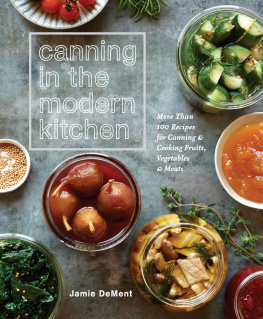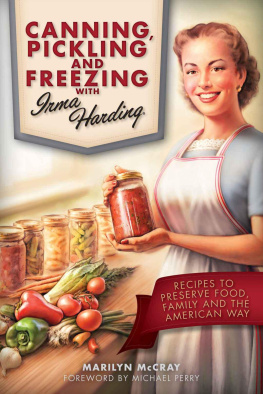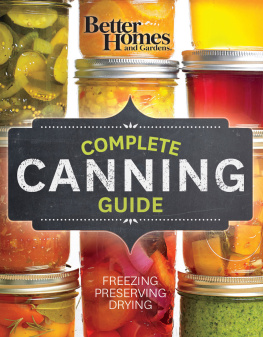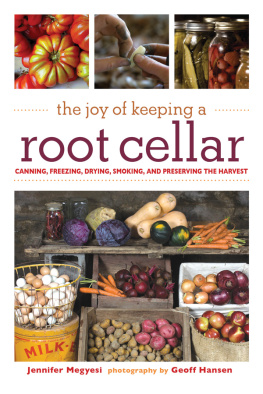THE BIG BOOK OF
Preserving THE Harvest
Carol W. Costenbader

The mission of Storey Publishing is to serve our customers by publishing practical information that encourages personal independence in harmony with the environment.
Edited by Pamela Lappies, Julia Rubel, and Karen Levy; expert review by Joanne Lamb Hayes
Cover and text design by Cynthia McFarland; text production by Erin Lincourt, Susan Bernier, and Kelley Nesbit
Cover art by Jane Davies
Chapter opener art by Carolyn Bucha, illustrations by Alison Kolesar, except pages 325, 326, 327, and 328 by Wendy Edelson; pages 83 and 290 by Judy Eliason; pages 13, 113, and 287 by Brigita Fuhrmann; (top) by Charles Joslin; pages 28 (top and center), 31 (left and center), 116, and 245 by Doug Merrilees; and pages 35 (top), 38 (left), 39 (top), 42 (top left and top right), 43 (top left, top right, and bottom right), 44 (bottom), 79, 80, 88 (top), 120, 250, 251 (top left and bottom left), 310, and 312 by Elayne Sears.
Indexed by Susan Olason, Indexes + Knowledge Maps
1997, 2002 by Carol W. Costenbader
All rights reserved. No part of this book may be reproduced without written permission from the publisher, except by a reviewer who may quote brief passages or reproduce illustrations in a review with appropriate credits; nor may any part of this book be reproduced, stored in a retrieval system, or transmitted in any form or by any means electronic, mechanical, photocopying, recording, or other without written permission from the publisher.
The information in this book is true and complete to the best of our knowledge. All recommendations are made without guarantee on the part of the author or Storey Publishing. The author and publisher disclaim any liability in connection with the use of this information. For additional information please contact Storey Publishing, 210 MASS MoCA Way, North Adams, MA 01247. Storey books are available for special premium and promotional uses and for customized editions. For further information, please call 800-793-9396. Note: Many of the food preservation procedures described in this book are subject to U.S. Department of Agriculture guidelines. Storey updates information upon publication of each edition and encourages readers to check for the most current standards by writing to Cooperative State Research, Education and Extension Service, U.S. Department of Agriculture, Washington, DC, 20250-0900; calling 202-720-7441; or visiting the agencys Web site at www.csrees.usda.com. You may also contact the extension service in your county. In Canada, contact Public Information Request Service, Agriculture and Agri-Food Canada, Sir John Carling Building, 930 Carling Avenue, Ottawa, Ontario K1A 0C5; 613-759-1000; or visit the agencys Web site at www.agr.gc.ca.
The Big Book of Preserving the Harvest was first published in 1997. All of the information in the previous edition was reviewed and updated.
Printed on recycled paper in the United States by Versa Press
20 19 18 17 16 15
LIBRARY OF CONGRESS CATALOGING-IN-PUBLICATION DATA
Costenbader, Carol W.
The big book of preserving the harvest: 150 recipes for freezing, canning, drying, and pickling fruits and vegetables / Carol W. Costenbader. Rev. ed.
p. cm.
Includes index.
ISBN 978-1-58017-458-9 (alk. paper)
1. Canning and preserving. I. Title.
TX603.C763 2002
641.4dc21
2002021172
CONTENTS
ACKNOWLEDGMENTS TO THE FIRST EDITION
Special thanks to Lynda Spivey, Family and Consumer Educator,
North Carolina Cooperative Extension Service;
Lane W. Byrd, a typist who is also a great cook;
my husband, the gardener in the family;
Pamela Lappies, my editor;
Julia Rubel, production editor;
and Nancy Ringer, editorial assistant.
Deo Sit Gloria.
The second editon is dedicated to the
memory of Carol W. Costenbader.
Introduction
ONE OF MY FONDEST MEMORIES of childhood is playing in my grandmothers pantry the smell of the onion bin; the way the air stayed cool, even in the hot summertime. Sometimes the mouthwatering aroma of ham from Sunday dinner wafted out to greet you when you opened the door. The floor space under the bottom shelf made a great cubbyhole for hiding away. There were endless rows of pickles watermelon rind, green tomato, bread and butter stacks of colorful jam jars, and rows of mixed vegetables. Granny must have felt rich. In those times, preserving was a necessary economy.
In earliest history, a new age began with the discovery of drying as a way of preserving. How revolutionary to be able to save meat and produce from a time of abundance into the leaner winter months. Around 3000 B.C.E. the Egyptians preserved herbs in their precious olive oils. Fishermen in Biblical times dried their catch in the hot, dry open air. In colonial times, Native Americans shared their methods of drying corn and meat with early European settlers. That help meant the difference between living and dying as winter took its toll.
In the early nineteenth century, Frenchman Nicolas Appert devised a way to preserve food by heating it in a sealed container. From there Louis Pasteur, another Frenchman and scientist, documented sterilization as a way to destroy dangerous microorganisms that spoil food. With these discoveries, preserving food had become a science instead of folklore. The metal can and the glass canning jar were improved. Electricity and the advent of refrigeration soon revolutionized food storage. Refrigeration became so popular that the old methods of preserving the harvest were not widely used.
TIP
To avoid frustrating delays, gather together all the equipment before starting your recipe.
Todays families often turn to food preservation as an inexpensive and time-saving way to have chemical-free food that prolongs the abundance and flavors of summer. Because I have preserved much of the harvest of seasons past, I can serve almost any condiment, relish, chutney, or fancy pickle from my own pantry and for far less than the cost at expensive specialty food stores.

The Big Book of Preserving the Harvest considers all forms of food preservation for todays busy families. We seldom rely on the methods our grandmothers used because of what we now know about the dangers of bacteria. But we have at our disposal an array of new appliances that make the job of preserving healthy, safe, and simple. Here are the best of Grannys offerings updated into safe, creative, good-tasting recipes everyone can use.
TIP
Try preserving in small batches, particularly if you are a beginner.
As you might guess, my kitchen is set up for almost any food preservation method, and having the proper equipment makes getting started that much easier. Nothing is more frustrating than realizing in the middle of a recipe that you are lacking a key piece of equipment. The beginner need not invest in every single piece of equipment mentioned in this book, but its a good idea to purchase everything you will need for the particular method you choose. The good news is that many of the items mentioned are standard kitchen equipment.
When the harvest is rolling in, my philosophy is to gather either enough produce for one recipe of a canned product usually four to eight jars, or two recipes of a frozen product one for dinner that night and one for the freezer. Preserving in small batches does away with the long hours of preparation, and frequently you can complete that evenings dinner at the same time. Picking small batches assures impeccable freshness.


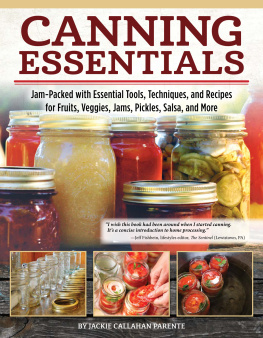
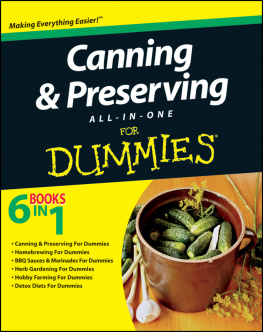
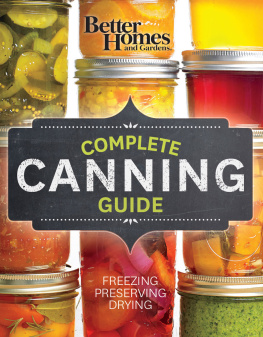
![Better Homes - Better homes and gardens you can can: [a guide to canning, preserving, and pickling]](/uploads/posts/book/188232/thumbs/better-homes-better-homes-and-gardens-you-can.jpg)
